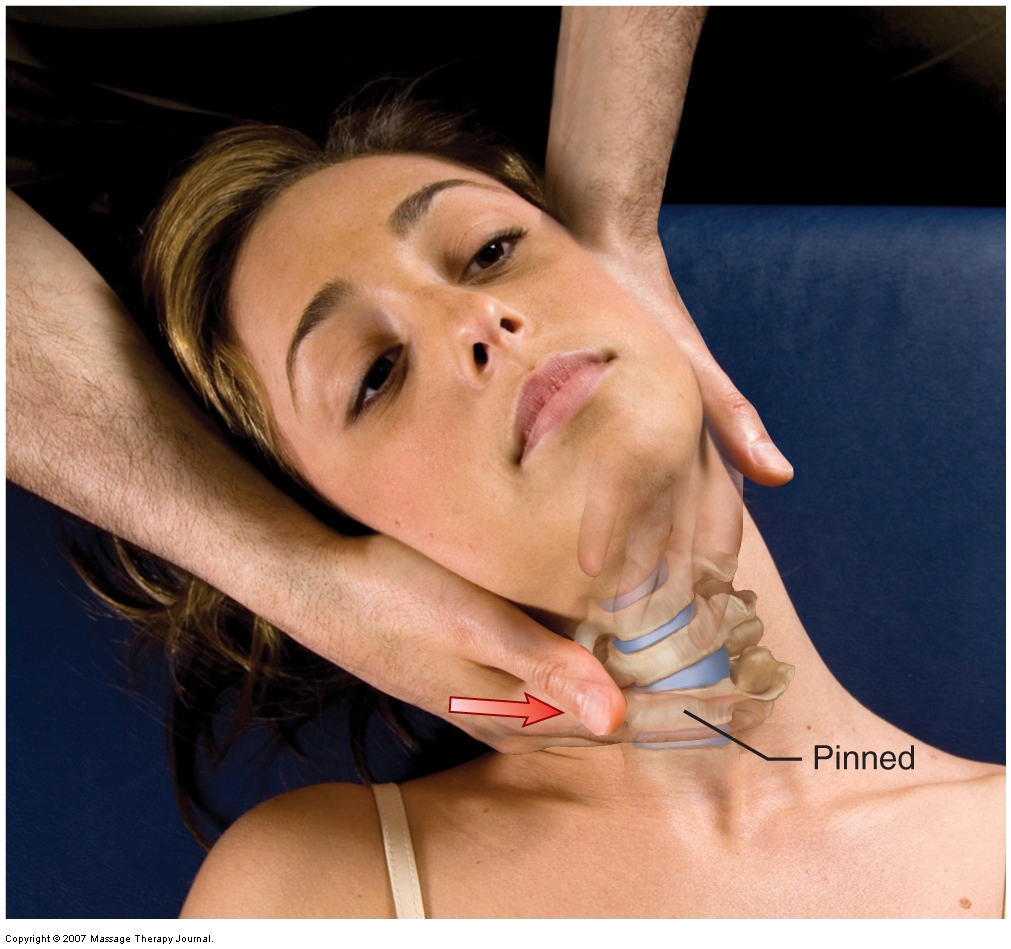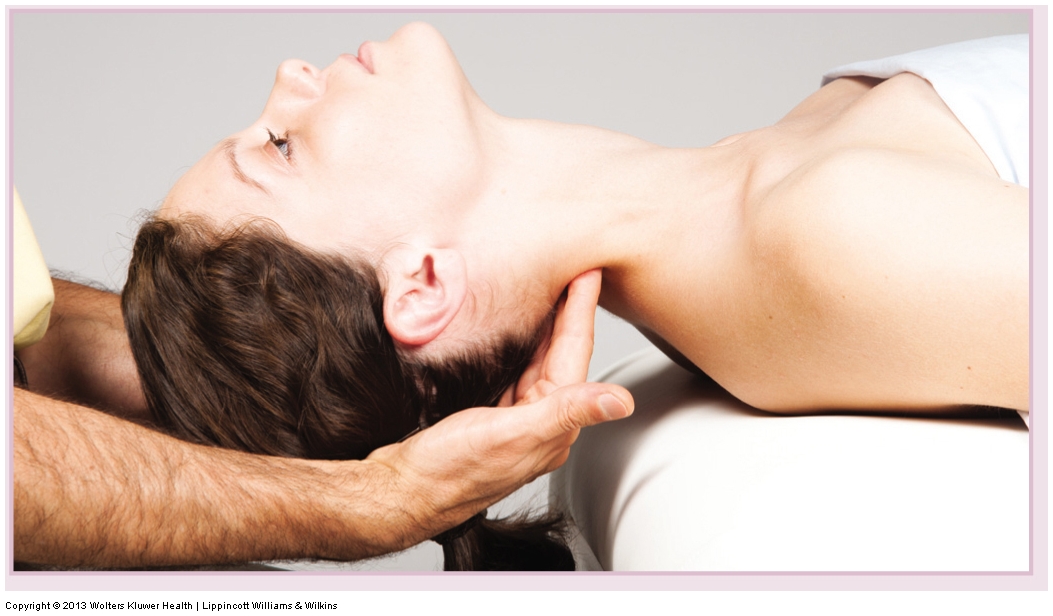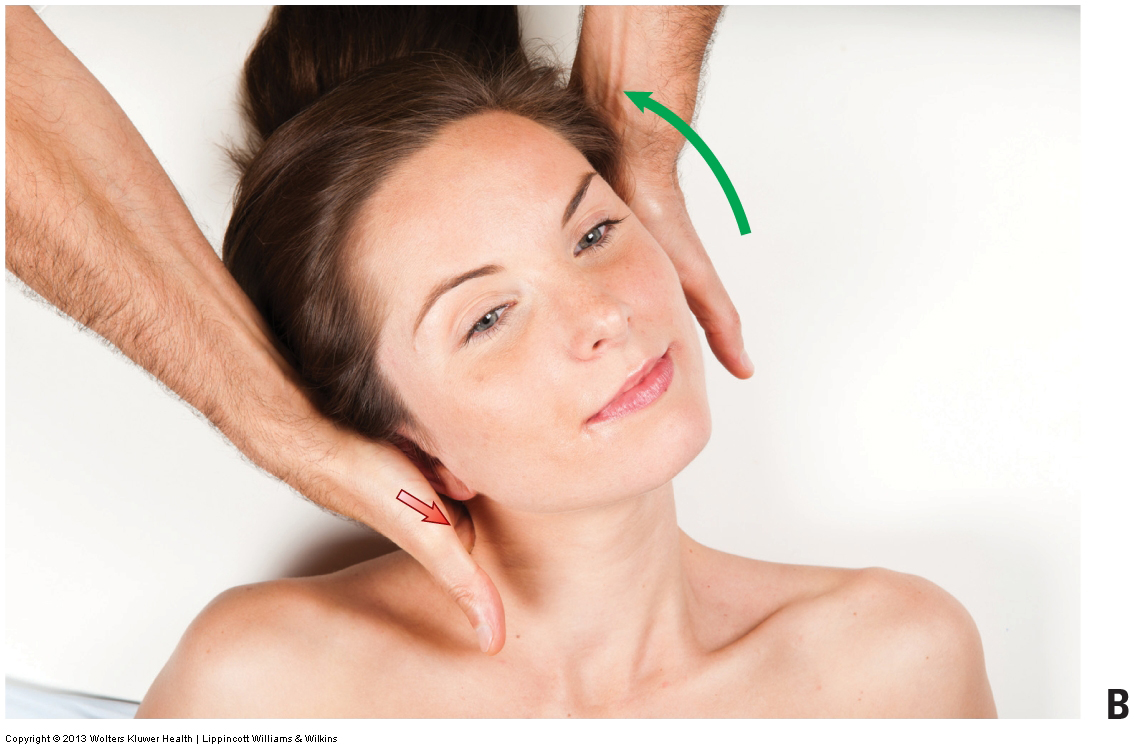Note: This is the seventh blog post article in a series of 14 articles on Assessment/Diagnosis of musculoskeletal conditions of the neck (cervical spine). See below for the other articles in this series.
Motion palpation, also known as joint play assessment, is essentially a focused and specific form of passive (pin and stretch technique) ROM assessment.
 Figure 5. Right lateral flexion joint play assessment of the neck. One vertebra is pinned (stabilized) and the vertebra immediately superior is moved into right lateral flexion relative to it. (Courtesy Joseph E. Muscolino. Originally published in the massage therapy journal (mtj): joint mobilization of the neck. Fall 2007. Photography by Yanik Chauvin.)
Figure 5. Right lateral flexion joint play assessment of the neck. One vertebra is pinned (stabilized) and the vertebra immediately superior is moved into right lateral flexion relative to it. (Courtesy Joseph E. Muscolino. Originally published in the massage therapy journal (mtj): joint mobilization of the neck. Fall 2007. Photography by Yanik Chauvin.)
Instead of moving or stretching the entire neck in a certain direction, the motion is directed at one segmental joint level. This is important because it helps narrow down the area where the problem exists. For example, if the therapist passively moves the client’s entire neck into right lateral flexion and the motion is decreased, the only information that procedure reveals is decreased motion, or hypomobility, exists in that direction. It does not reveal whether every joint of the neck is hypomobile in that direction, or whether the hypomobility is present at just one or a few of the segmental joint levels. Motion palpation assessment makes it possible to discern this.
In fact, it is entirely possible for there to be a hypomobile joint level within the neck in right lateral flexion passive ROM while the entire neck has a normal degree of motion. If one segmental level is hypomobile and produces insufficient movement, another adjacent joint level might become hypermobile to compensate. This makes it possible for the gross ROM of the entire neck to be normal while cervical hypomobilities and hypermobilities are present. Therefore, the only way to determine the health of a specific segmental joint level is to employ motion palpation assessment.

Performing Motion Palpation
Motion palpation assessment is performed similarly to the joint mobilization technique, which is the technique used to treat joint dysfunction of the cervical spine. The therapist pins (fixes/stabilizes) one cervical vertebra by contacting it with the stabilization hand at the articular process, while moving the vertebra immediately above (along with the head and any other vertebrae that are located superior to the pinned vertebra) relative to the lower vertebra (see Fig. 5 above). This procedure isolates the motion to the segmental joint level that is located between these two vertebrae, thereby allowing the therapist to assess specifically that joint level’s end-feel motion. By performing motion palpation assessment at each level of the neck, it is possible to assess specific hypomobilities and hypermobilities throughout the cervical spine and target treatment to those levels. Motion palpation assessment is also known as joint play assessment.
- It should be pointed out that motion palpation assessment technique (and joint mobilization treatment technique) is essentially a form of pin and stretch technique.
- But instead of pinning in the middle of a muscle belly and then stretching that muscle by moving one of its attachments, we pin on one bone and then stretch the other bone at the joint to focus the stretch challenge to the intrinsic fascial tissue (ligament/joint capsule complex) of the joint.
Motion Palpation Assessment
Motion palpation assessment, like joint mobilization technique, is performed by bringing the client’s joint to the end of its passive ROM, and then gently applying an even, steady force that further stretches the intrinsic fascial tissue of the joint in the desired direction. It cannot be emphasized too strongly that the force applied to assess joint play must be gentle, even, and steady. Motion palpation assessment assessment and joint mobilization technique (when performed as a Grade IV joint mobilization) should never involve any type of fast or sudden thrust. A fast thrust within the realm of joint play is defined as a Grade V joint mobilization, and often thought of as a chiropractic or osteopathic adjustment and cannot be legally/ethically performed by most manual therapists.
Before employing motion palpation/mobilization, it is important to be sure that it is within the scope of practice of your profession. If there is any doubt about the ethical or legal application of motion palpation/mobilization within your profession, please check with your local, state, or provincial licensing body, your certifying body, and/or your professional organization.

(Click here for a blog post article on motion palpation of the lumbar spine and sacroiliac joints.)
This blog post article is the seventh in a series of 14 blog post articles on Assessment/Diagnosis of musculoskeletal (neuro-myo-fascio-skeletal) conditions of the neck (cervical spine).
The articles in this series are:
- Introduction to Assessment/Diagnosis of the Neck
- Verbal and Written Health History
- Overview of Physical Examination Assessment
- Postural Assessment
- Neck General Orthopedic Assessment: Range of Motion and Manual Resistance Assessment
- Palpation Assessment
- Motion Palpation (Joint Play) Assessment
- Special Orthopedic Assessment Tests for the Neck – Space Occupying Conditions
- Special Orthopedic Assessment Tests – Space Occupying Conditions – Slump Test
- Orthopedic Assessment of Thoracic Outlet Syndrome – Adson’s, Eden’s, Wright’s
- Orthopedic Assessment of Thoracic Outlet Syndrome – Brachial Plexus Tension Test
- Special Orthopedic Assessment Tests – Vertebral Artery Competency Test
- Treatment Strategy and Treatment Techniques
- Assessment and Treatment of Specific Musculoskeletal Conditions


